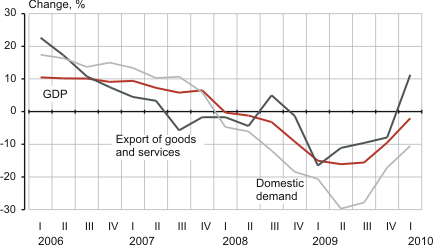Deceleration of the economic decline continued in the 1st quarter
The deceleration of the economic decline continued successively already for the third quarter. In the 3rd quarter of 2009, the GDP decreased by 15.6% and in the 4th quarter 9.5% compared to the same quarter of the previous year.
Among other things, the deceleration of the decrease of the GDP in the 1st quarter was influenced by low comparing base of 2009.
Seasonally and working day adjusted GDP decreased in the 1st quarter compared to the 4th quarter of the previous year 2.0% (in the 4th quarter of 2009 the growth was 2.4% compared to the previous quarter.)
In the 1st quarter, the GDP at current prices was 50.5 billion kroons.
Domestic demand was continually weak with the share of only 94% of the GDP. At the same time, the decrease of the domestic demand decelerated to -11% influenced mostly by the continually steep decrease of the gross fixed capital formation (23%) above all due to the decrease in investments in buildings and structures by corporations and general government sector.
The decrease in inventories starting from the 4th quarter of 2008 continued also in the 1st quarter this year.
Households’ final consumption expenditure decreased annually by 8% influenced at most by the decrease in expenditures on transport, which accounted for approximately one third of the total sum of the decreased households’ expenditures. In real terms, expenditures increased only on housing (on electricity and fuels).
Real growth of the GDP and of its components compared to the same quarter of the previous year, 1st quarter 2006 – 1st quarter 2010
Export of goods increased by 19% in real terms in the 1st quarter influenced on the one hand by extraordinary big exports of refined petroleum products, as well as by the low comparing base of the 1st quarter of 2009. Export of services decreased and the aggregate export of goods and services increased by 11%. Export increased last in the 3rd quarter of 2008. Despite the weak domestic demand, import of goods increased by 6% in real terms, influenced mainly by the increase in imports of textiles, paper and paper products. Import of services decreased and the aggregate import of goods and services increased by 3%. Import increased last in the 4th quarter of 2007. Exports of goods and services exceeded imports since the 1st quarter of the previous year. However, the positive rate of net exports in the GDP decreased already for the third quarter. In the 1st quarter this year the rate of net exports in the GDP was 2.8%.
In the 1st quarter the value added increased in seven economic activities: forestry, mining, manufacturing, electricity, gas and water supply, financial intermediation, public administration and defence and education. The value added of these economic activities accounted for 42% of the gross value added and their contribution to the decrease of the GDP was 1.2 percentage points.
The decrease of the value added of the industrial sector decelerated to -2% (in the 4th quarter of 2009 the decrease was -17%), largely based on convalesce of external demand and increase in the exports of industrial production. The increase of the value added in manufacturing was influenced at most by the growth of the value added in manufacture of wood and wood products, of refined petroleum products, transport equipment, electrical and optical equipment and of rubber and plastic products. Whereas the domestic demand was small, the sales of manufacturing on the domestic market were still in downtrend. At the same time, exports of the products from manufacturing increased. The increase in the value added in electricity, gas and water supply was influenced on the one hand by the increase of exports of the energy and, at the same time, by bigger demand of energy on the domestic market due to the unusual cold winter period. The decrease in the value added of the construction even accelerated as its output is mainly targeted on the domestic market. When the decrease of the value added of the construction was mainly caused by the decline of the construction of buildings on the domestic market, then due to the more severe weather conditions at the beginning of this year construction of structures decreased as well.
The increase of the value added of the financial intermediation was mostly contributed by the increase of commissions’ income by the enterprises of this activity.
Industrial sector consists of mining, manufacturing, electricity, water and gas supply and construction activity, accounting for approximately a quarter of the gross value added of the total economy.
Statistics Estonia releases regular revision of 2006–2009 based on supply and use tables and annual business reports on the 8th September. As 2009 is revised as well, the updated data for the 1st quarter of 2010 will be published on the same date. See the review about regular revisions: /uudised/national-accounts.
